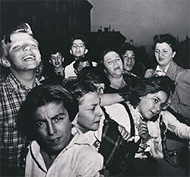|
This picture was originally published with the headline "Brooklyn School Children See Gambler Murdered in Street," and this caption: "Pupils were just leaving P.S. 143 when a small-time gambler, pulled up at a traffic light a block from the school. Up to the car stepped a waiting gunman, who fired twice and escaped through the throng of children..." The image is a good example of how flash changes the scene, casting background detail into generalized darkness.
Weegee began his police-beat photography during the Depression years, when crime had glamorous associations. Gangster movies, the novels of Raymond Chandler and Dashiell Hammett, and the comic strip Dick Tracy bolstered interest in the cops, detectives and, by association, the crime photographers who dealt with these dangerous heroes.
|
 |
 |
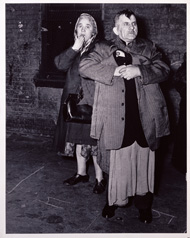
 |
 |
Fire Alarm / A Couple Driven out from the Burning Tenement, Weegee, April 23, 1944
© International Center of Photography
|
 |
Weegee points out in his book Naked City (1945) that his fire pictures were not only destined for the news media but were also useful as evidence "for the detectives and fire marshals who are always on the scene...on the look out for pyromaniacs" and to end disputes about who actually made the rescues, since "different firemen will take credit." The publication PM ran this image nearly full page on April 23, 1944, with details about how the city's Emergency Welfare Division assisted citizens who were burned out of their homes.
|
 |
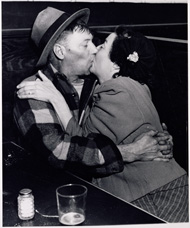
 |
 |
Couple Kissing in a Bar, Weegee, negative, about 1942; print, about 1950
© International Center of Photography
|
 |
 |
Weegee never let an embrace escape his camera. At least that would appear to be the case based on the enormous number of kissing couples found in his archive after his death and their appearance in publications of his work, from a section in Naked City (1945) called "Lovemaking on the Beach," to a 1947 Look magazine article on contemporary American morals, to the posthumous book, The Village (1989), which features an abundance of young lovers.
When Weegee wanted to shoot "people doing things they never would do if they thought I was watching them," he would often use a triangular prism lens attachment to "see around corners."
|
 |
 |
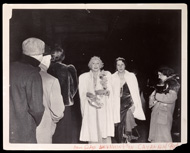
 |
 |
The Critic, Weegee, November 22, 1943
© International Center of Photography
|
 |
The beginning of the new opera season was an annual New York ritual Weegee routinely covered for the press. The job provided rich material for Weegee's satirical bent.
The Critic, presenting Mrs. George W. Kavanaugh, her friend Lady Decies, and a bystander brought by Weegee from a Bowery bar, became one of the photographer's best-known works. Life magazine cropped the picture to eliminate the "plain people" at left in its November 22, 1943, coverage of the fall Metropolitan Opera opening.
|
 |
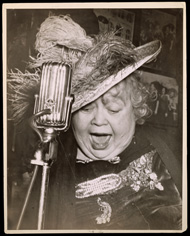
 |
 |
Songstress at Sammy's / Dora, Weegee, April 16, 1944
© International Center of Photography
|
 |
 |
Sammy Fuchs, founder of Sammy's on the Bowery in New York City, offered entertainment as well as drink. There, Dora, Billie Dauscha, Mabel Sidney, and others performed, singing "sentimental songs," as Weegee referred to them, for an audience that usually ranged from uptown swells to flophouse residents.
Customers of all types flocked to Sammy's as it gained a reputation for being what Weegee called "the poor man's Stork Club," an alternative to that highbrow nightclub. Weegee devoted a section titled "The Bowery" to Sammy's in his book Naked City (1945); Fuchs, in turn, hosted a raucous publication party for the author.
|
 |
 |
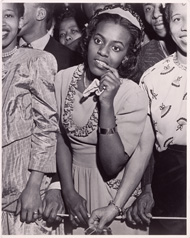
 |
 |
At the Concert in Harlem, Weegee, negative, before 1946; print, about 1950
© International Center of Photography
|
 |
When Weegee compiled his second book, Weegee's People (1946), he concentrated on the social life of New Yorkers and chose many Harlem images, including this one. The book's extensive "Saturday Night" section contains pictures of dancers, performers, and partygoers enjoying themselves in nightclubs, bars, and dance halls.
Perhaps made at the Savoy Ballroom on Lenox Avenue, a popular venue for musicians like Duke Ellington, or the Apollo Theater on 125th Street, a great success with black and white audiences, this composition displays Weegee's trademark use of the unconscious gesture.
|
 |
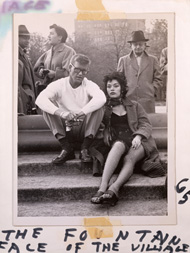
 |
 |
The Fountain / Face of the Villiage [sic], Weegee, about 1955
© International Center of Photography
|
 |
 |
Weegee claimed that Greenwich Village was for him what the Montmartre section of Paris had been for the French artist Henri de Toulouse-Lautrec. He photographed this downtown community of artists, writers, and radicals for decades and compiled a book dummy of selected images, which was issued posthumously in 1989 as The Village.
Weegee's opening statement to the book reflects his reasons for recording the neighborhood: "I continually photographed the Village...compiling a memento of a place that seemed to be fast disappearing. New York University is tearing down all the old buildings and putting up more classrooms so they can teach Ceramics, Square Dancing, and primitive Painting à la Grandma Moses."
The exhibition is located at the Getty Center, Museum, West Pavilion.
|
 |
